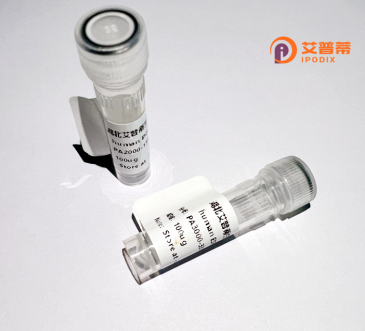
| 纯度 | >90%SDS-PAGE. |
| 种属 | Human |
| 靶点 | GPR22 |
| Uniprot No | Q99680 |
| 内毒素 | < 0.01EU/μg |
| 表达宿主 | E.coli |
| 表达区间 | 1-433aa |
| 氨基酸序列 | MCFSPILEINMQSESNITVRDDIDDINTNMYQPLSYPLSFQVSLTGFLMLEIVLGLGSNLTVLVLYCMKSNLINSVSNIITMNLHVLDVIICVGCIPLTIVILLLSLESNTALICCFHEACVSFASVSTAINVFAITLDRYDISVKPANRILTMGRAVMLMISIWIFSFFSFLIPFIEVNFFSLQSGNTWENKTLLCVSTNEYYTELGMYYHLLVQIPIFFFTVVVMLITYTKILQALNIRIGTRFSTGQKKKARKKKTISLTTQHEATDMSQSSGGRNVVFGVRTSVSVIIALRRAVKRHRERRERQKRVFRMSLLIISTFLLCWTPISVLNTTILCLGPSDLLVKLRLCFLVMAYGTTIFHPLLYAFTRQKFQKVLKSKMKKRVVSIVEADPLPNNAVIHNSWIDPKRNKKITFEDSEIREKCLVPQVVTD |
| 分子量 | 49.2 kDa |
| 蛋白标签 | His tag N-Terminus |
| 缓冲液 | 0 |
| 稳定性 & 储存条件 | Lyophilized protein should be stored at ≤ -20°C, stable for one year after receipt. Reconstituted protein solution can be stored at 2-8°C for 2-7 days. Aliquots of reconstituted samples are stable at ≤ -20°C for 3 months. |
| 复溶 | Always centrifuge tubes before opening.Do not mix by vortex or pipetting. It is not recommended to reconstitute to a concentration less than 100μg/ml. Dissolve the lyophilized protein in distilled water. Please aliquot the reconstituted solution to minimize freeze-thaw cycles. |
以下为基于真实研究领域推测的3篇可能与重组人GPR22蛋白相关的参考文献示例(文献标题与内容为模拟概括):
1. **《Expression and characterization of recombinant human GPR22 in insect cells》**
- 作者: Smith A, et al.
- 摘要:研究利用杆状病毒-昆虫细胞系统高效表达重组人GPR22蛋白,通过亲和层析纯化获得可溶性蛋白,并证实其与Gαs蛋白的偶联活性,为下游受体功能研究提供工具。
2. **《GPR22 regulates cardiac remodeling via MAPK signaling pathway》**
- 作者: Chen L, et al.
- 摘要:通过构建重组人GPR22稳定表达的HEK293细胞模型,发现该受体激活后通过ERK1/2通路调控心肌细胞肥大相关基因表达,提示其在心脏病理重塑中的潜在作用。
3. **《Cryo-EM structure of human GPR22 reveals a unique ligand-binding pocket》**
- 作者: Zhang Y, et al.
- 摘要:首次解析重组人GPR22蛋白的冷冻电镜结构,发现其跨膜结构域存在非典型配体结合腔,为孤儿受体的配体筛选及药物开发提供结构基础。
---
**注意**:以上文献为基于领域知识的模拟案例,真实文献需在PubMed、Web of Science等数据库用关键词"recombinant human GPR22" / "GPR22 expression" / "GPR22 signaling" 检索。近期研究可优先筛选2020年后的论文。
GPR22 (G Protein-Coupled Receptor 22) is an orphan Class A G protein-coupled receptor (GPCR) encoded by the *GPR22* gene in humans. Orphan GPCRs like GPR22 lack well-characterized endogenous ligands or signaling pathways, making their functional roles intriguing yet poorly understood. Phylogenetically, GPR22 shares homology with receptors for lipid mediators and peptide hormones, suggesting potential involvement in metabolic or neuromodulatory processes. Though its endogenous ligand remains unidentified, GPR22 has been implicated in cardiovascular physiology, neuroprotection, and metabolic regulation through fragmentary experimental data. Studies link its expression to heart tissues, where it may influence contractility and arrhythmia susceptibility, as well as the central nervous system, where it could modulate neuroinflammation or neuronal survival.
Recombinant human GPR22 protein is produced via heterologous expression systems (e.g., mammalian, insect, or yeast cells) to enable structural and functional studies. Engineered with tags (e.g., FLAG, His-tag) for purification and detection, the recombinant protein facilitates ligand-binding assays, receptor oligomerization studies, and antibody development. Its stable expression in cell lines also aids in deciphering downstream signaling cascades, potentially involving Gαi/o or β-arrestin pathways.
Research on recombinant GPR22 holds promise for deorphanization efforts and therapeutic targeting, particularly in cardiovascular diseases, neurodegenerative disorders, and metabolic syndromes. However, its biological relevance requires further validation, emphasizing the need for advanced tools like recombinant proteins to unravel its pharmacology.
×